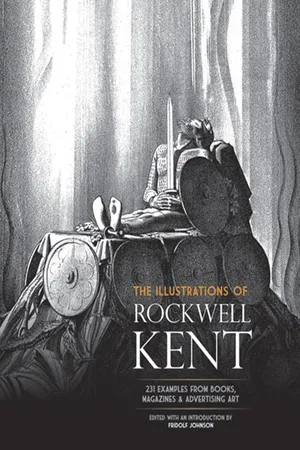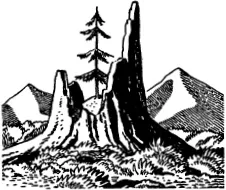
eBook - ePub
The Illustrations of Rockwell Kent
231 Examples from Books, Magazines and Advertising Art
- 144 pages
- English
- ePUB (mobile friendly)
- Available on iOS & Android
eBook - ePub
The Illustrations of Rockwell Kent
231 Examples from Books, Magazines and Advertising Art
About this book
Rockwell Kent (1882-1971) was probably the most important American book illustrator of the 1920s and '30s. Today there is a revival of interest in his illustrations, and this volume brings together for the first time the best of his illustrations from 24 books, as well as magazine art, bookplates, and advertising material--231 examples in all.
Many of his most famous illustrations are included, with several selections each from Candide (1928), Moby Dick (1930), The Canterbury Tales of Geoffrey Chaucer (1930), Salamina (1935), The Complete Works of William Shakespeare (1936), and Goethe's Faust (1941), among others. Illustrations for lesser-known works such as A Basket of Poses (1924), Venus and Adonis (1931), and To Thee, America! (1946) are also reproduced. The entire collection is dominated by Kent's highly individual style of formalized realism and by his well-known subject matter--heroic, or sensual, male and female figures and dramatic scenes of nature, usually in a far-off wilderness. Concentrating on the exceptional works of the '20s and '30s, the volume does include some early material from 1914 and 1915, and a selection of later work from the 1940s and from Rockwell Kent's Greenland Journal (1963).
Fridolf Johnson, for many years editor of The American Artist and a respected designer, has written a new introduction tracing Kent's development as an illustrator, captions for the illustrations, and an annotated bibliography of the works represented. The illustrations have been selected by Fridolf Johnson with the collaboration of John F. H. Gorton, Director, The Rockwell Kent Legacies.
Frequently asked questions
Yes, you can cancel anytime from the Subscription tab in your account settings on the Perlego website. Your subscription will stay active until the end of your current billing period. Learn how to cancel your subscription.
No, books cannot be downloaded as external files, such as PDFs, for use outside of Perlego. However, you can download books within the Perlego app for offline reading on mobile or tablet. Learn more here.
Perlego offers two plans: Essential and Complete
- Essential is ideal for learners and professionals who enjoy exploring a wide range of subjects. Access the Essential Library with 800,000+ trusted titles and best-sellers across business, personal growth, and the humanities. Includes unlimited reading time and Standard Read Aloud voice.
- Complete: Perfect for advanced learners and researchers needing full, unrestricted access. Unlock 1.4M+ books across hundreds of subjects, including academic and specialized titles. The Complete Plan also includes advanced features like Premium Read Aloud and Research Assistant.
We are an online textbook subscription service, where you can get access to an entire online library for less than the price of a single book per month. With over 1 million books across 1000+ topics, we’ve got you covered! Learn more here.
Look out for the read-aloud symbol on your next book to see if you can listen to it. The read-aloud tool reads text aloud for you, highlighting the text as it is being read. You can pause it, speed it up and slow it down. Learn more here.
Yes! You can use the Perlego app on both iOS or Android devices to read anytime, anywhere — even offline. Perfect for commutes or when you’re on the go.
Please note we cannot support devices running on iOS 13 and Android 7 or earlier. Learn more about using the app.
Please note we cannot support devices running on iOS 13 and Android 7 or earlier. Learn more about using the app.
Yes, you can access The Illustrations of Rockwell Kent by Rockwell Kent, Fridolf Johnson in PDF and/or ePUB format, as well as other popular books in Art & Artist Monographs. We have over one million books available in our catalogue for you to explore.
Information
Topic
ArtSubtopic
Artist MonographsINTRODUCTION

During the 88 years of his life, Rockwell Kent achieved equal prominence as a painter, writer, traveler, and social polemicist. Louis Untermeyer, writing in the Special Rockwell Kent Number of American Book Collector, summer, 1964, proclaimed him “the most versatile man alive ... I have known him as a painter, pamphleteer, poet (in private), politician (a poor one), propagandist, lecturer, explorer, architect (he re-designed my home in the Adirondacks), grave-digger, farmer, illustrator, Great-Dane-breeder, typographic designer, xylographer (‘wood-engraver’ to the uninitiated), friend, and general stimulator.” To a large segment of the public, however, he is remembered as the most important American book illustrator of his time, primarily for the works he illustrated during the twenties and thirties—Candide, Moby Dick, The Canterbury Tales and the complete Shakespeare, as well as his own books of travel.
This period was marked by frenetic activity in the production and collecting of limited editions and fine printing. Kent’s thorough understanding of typographic design, his individual, precise style of formalized realism and his techniques, so sympathetic to the printed page, made him the ideal illustrator for the kind of books appreciated by discriminating collectors. Most of his illustrated books were first published in expensive, superbly produced limited, signed editions, followed by more popularly priced trade editions having tremendous sales. Besides the then prevailing practice of issuing limited editions of fine books at higher prices, to defray the high cost of production, “special copies” with wider margins, extra plates, deluxe bindings, and other desiderata attractive to collectors were often published to bring in additional income. Rockwell Kent’s books were no exception, and they present a difficult problem for bibliographers.
Kent also had the gift for creating simple, compact vignettes of strong design admirably adaptable to page decorations, signets, and bookplates; he produced a great number of bookplates, much admired and assiduously collected, and two collections containing both bookplates and marks were published in limited editions, one in 1929 and the other in 1937. In addition, he contributed much outstanding work to numerous distinguished advertising campaigns.
Rockwell Kent was born June 21, 1882, at Tarrytown Heights, New York. That he chose to come into the world so early as four o’clock in the morning possibly suggests a proclivity and fund of energy which was to mark his entire life. He began his formal education at Horace Mann School in New York City. Later he wrote in It’s Me O Lord: The Autobiography of Rockwell Kent (Dodd, Mead & Company, New York, 1955), “Mechanical drawing was important in our curriculum; and, again, the high degree of craftsmanship that it demanded—of accuracy of measurement, of sheer draughtmanship in terms of utmost precision—not only served, however unsuspectedly by me, to incline me toward my eventual profession, but to train my hand for service to it. But of even greater importance was the stark, material realism of which such drawing is the expression. Our concern was not with what things looked like but with, what in all their dimensions, they essentially were.”
Of his early training there in fine art he writes caustically—and characteristically—that his generation was happily spared “all the silly, sensual indulgence in irresponsible self-expression that, from messy ‘finger painting’ to often messier abstractionism, characterizes much of the therapeutic school of art of today.” In school he developed a good Spencerian hand, and his ability to write well and embellish what he wrote with fanciful letters and decorative borders was quickly recognized and put to use. At fifteen he began to practice as a professional, receiving small commissions suitable to his talents.
Kent studied architecture at Columbia University, briefly practiced the profession, and set himself up as an expert on architectural rendering. Finding the work unrewarding, he turned his attention more and more to painting. He had already started to study painting under William Merritt Chase in the summer of 1900. He later went to the New York School of Art, established by Douglas John Connah, a fine man and painter who has received much less credit than he deserves. There he studied under Chase,...
Table of contents
- Cover Page
- Title Page
- Copyright Page
- The Illustrations of Rockwell Kent
- Back Cover